COPD and Respiratory Muscle Function: An Analysis of Multiple Studies
VerifiedAdded on 2022/12/15
|11
|2624
|284
Report
AI Summary
This technical report provides an analysis of seven research studies focused on the impact of Chronic Obstructive Pulmonary Disease (COPD) on respiratory muscle function. The studies explore various aspects including the correlation between diaphragm thickness and synergist muscle activity, the assessment of diaphragmatic function using ultrasound, and the relationship between respiratory muscle dysfunction and pulmonary hyperinflation. Methodologies employed include the use of spirometry, ultrasonography, electromyography (EMG), and structured light plethysmography to evaluate lung capacity, muscle activity, and tidal breathing patterns. The studies investigate the effects of COPD severity, age, and various treatments, such as non-invasive ventilation, on respiratory muscle function. Additionally, the report covers research on patients with thoracic scoliosis and the implications for respiratory muscle activation. The findings highlight the importance of early intervention and aggressive treatment for COPD patients to maintain normal breathing processes and manage the disease effectively. The report provides a comprehensive overview of the current research landscape in COPD and respiratory muscle function.
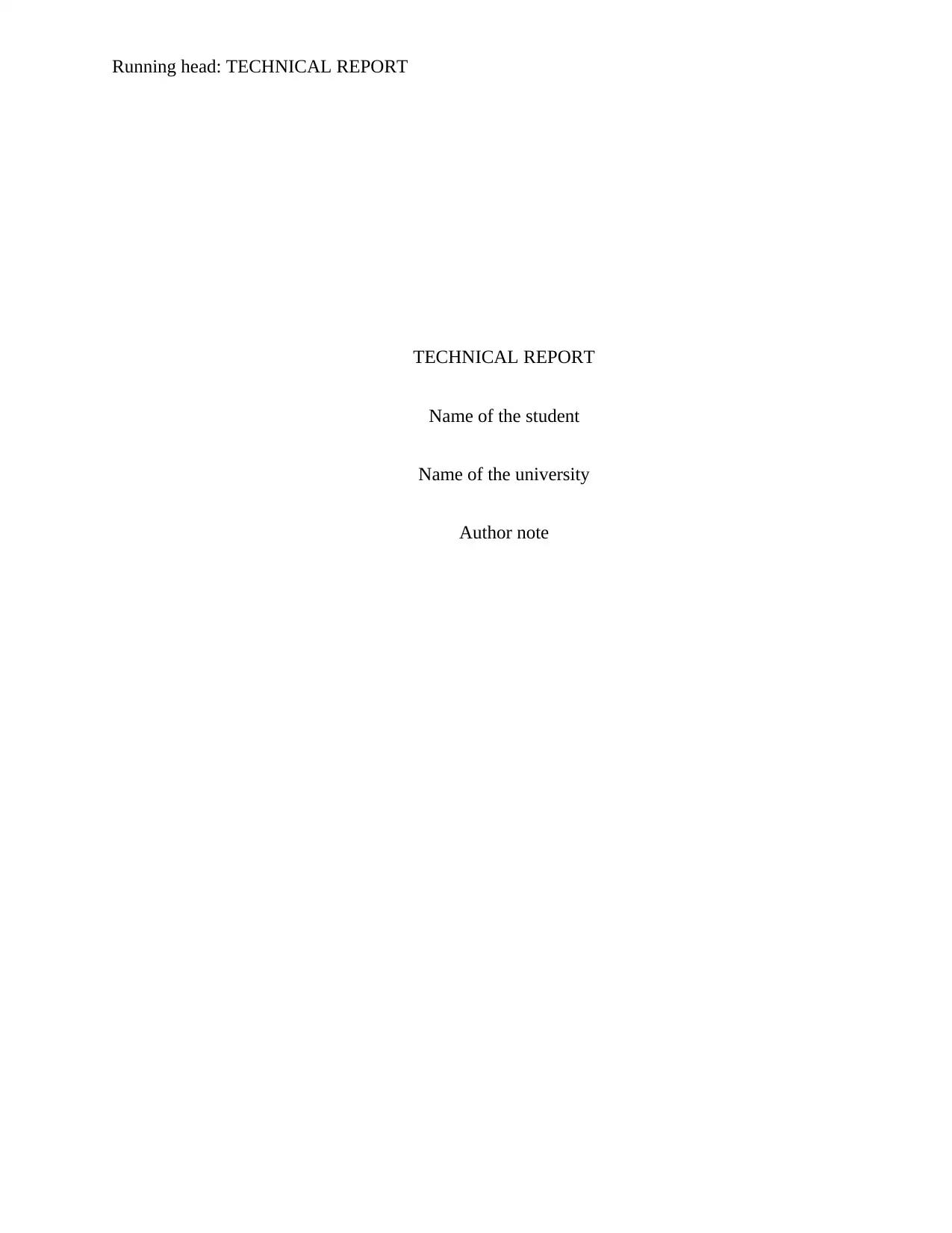
Running head: TECHNICAL REPORT
TECHNICAL REPORT
Name of the student
Name of the university
Author note
TECHNICAL REPORT
Name of the student
Name of the university
Author note
Paraphrase This Document
Need a fresh take? Get an instant paraphrase of this document with our AI Paraphraser
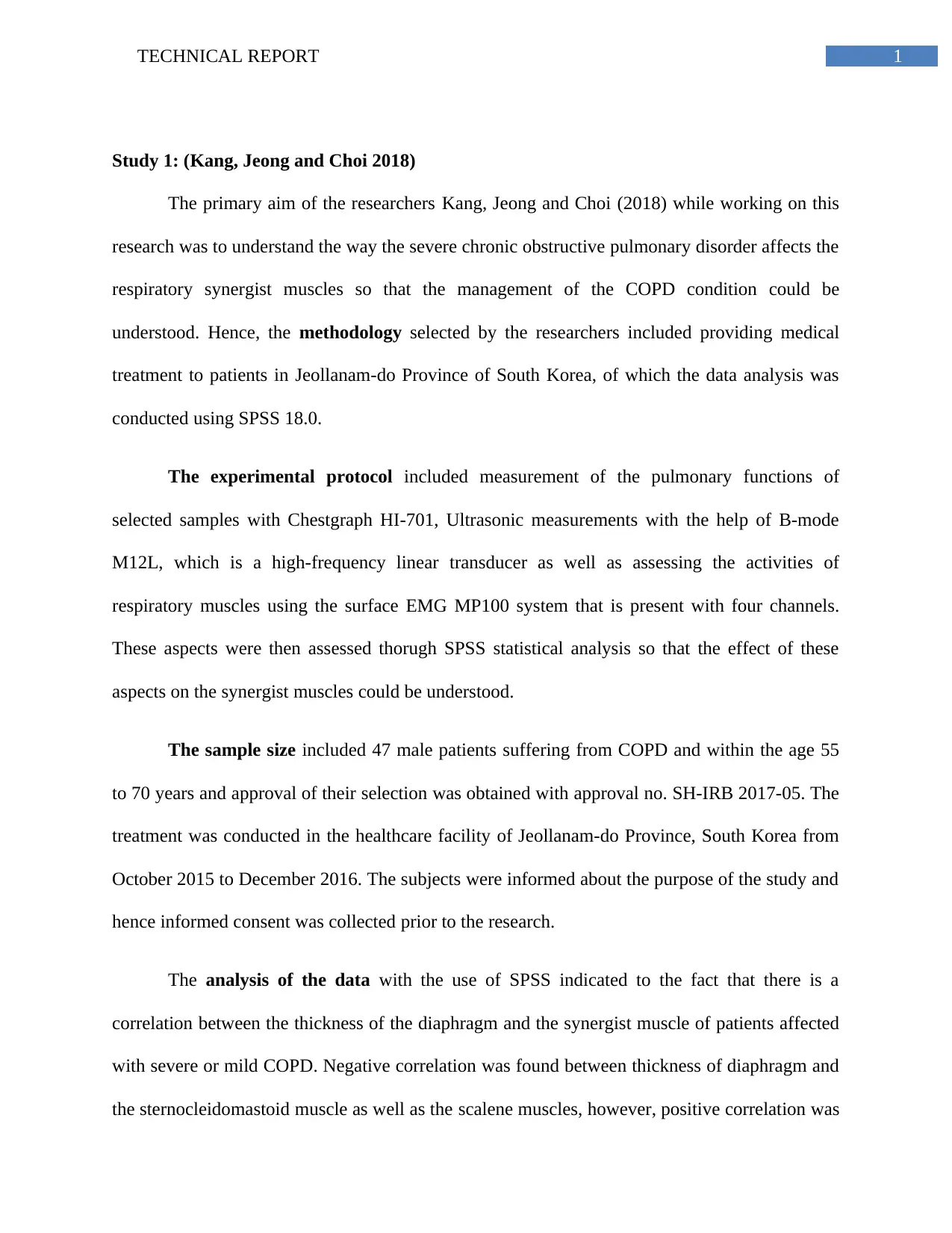
1TECHNICAL REPORT
Study 1: (Kang, Jeong and Choi 2018)
The primary aim of the researchers Kang, Jeong and Choi (2018) while working on this
research was to understand the way the severe chronic obstructive pulmonary disorder affects the
respiratory synergist muscles so that the management of the COPD condition could be
understood. Hence, the methodology selected by the researchers included providing medical
treatment to patients in Jeollanam-do Province of South Korea, of which the data analysis was
conducted using SPSS 18.0.
The experimental protocol included measurement of the pulmonary functions of
selected samples with Chestgraph HI-701, Ultrasonic measurements with the help of B-mode
M12L, which is a high-frequency linear transducer as well as assessing the activities of
respiratory muscles using the surface EMG MP100 system that is present with four channels.
These aspects were then assessed thorugh SPSS statistical analysis so that the effect of these
aspects on the synergist muscles could be understood.
The sample size included 47 male patients suffering from COPD and within the age 55
to 70 years and approval of their selection was obtained with approval no. SH-IRB 2017-05. The
treatment was conducted in the healthcare facility of Jeollanam-do Province, South Korea from
October 2015 to December 2016. The subjects were informed about the purpose of the study and
hence informed consent was collected prior to the research.
The analysis of the data with the use of SPSS indicated to the fact that there is a
correlation between the thickness of the diaphragm and the synergist muscle of patients affected
with severe or mild COPD. Negative correlation was found between thickness of diaphragm and
the sternocleidomastoid muscle as well as the scalene muscles, however, positive correlation was
Study 1: (Kang, Jeong and Choi 2018)
The primary aim of the researchers Kang, Jeong and Choi (2018) while working on this
research was to understand the way the severe chronic obstructive pulmonary disorder affects the
respiratory synergist muscles so that the management of the COPD condition could be
understood. Hence, the methodology selected by the researchers included providing medical
treatment to patients in Jeollanam-do Province of South Korea, of which the data analysis was
conducted using SPSS 18.0.
The experimental protocol included measurement of the pulmonary functions of
selected samples with Chestgraph HI-701, Ultrasonic measurements with the help of B-mode
M12L, which is a high-frequency linear transducer as well as assessing the activities of
respiratory muscles using the surface EMG MP100 system that is present with four channels.
These aspects were then assessed thorugh SPSS statistical analysis so that the effect of these
aspects on the synergist muscles could be understood.
The sample size included 47 male patients suffering from COPD and within the age 55
to 70 years and approval of their selection was obtained with approval no. SH-IRB 2017-05. The
treatment was conducted in the healthcare facility of Jeollanam-do Province, South Korea from
October 2015 to December 2016. The subjects were informed about the purpose of the study and
hence informed consent was collected prior to the research.
The analysis of the data with the use of SPSS indicated to the fact that there is a
correlation between the thickness of the diaphragm and the synergist muscle of patients affected
with severe or mild COPD. Negative correlation was found between thickness of diaphragm and
the sternocleidomastoid muscle as well as the scalene muscles, however, positive correlation was
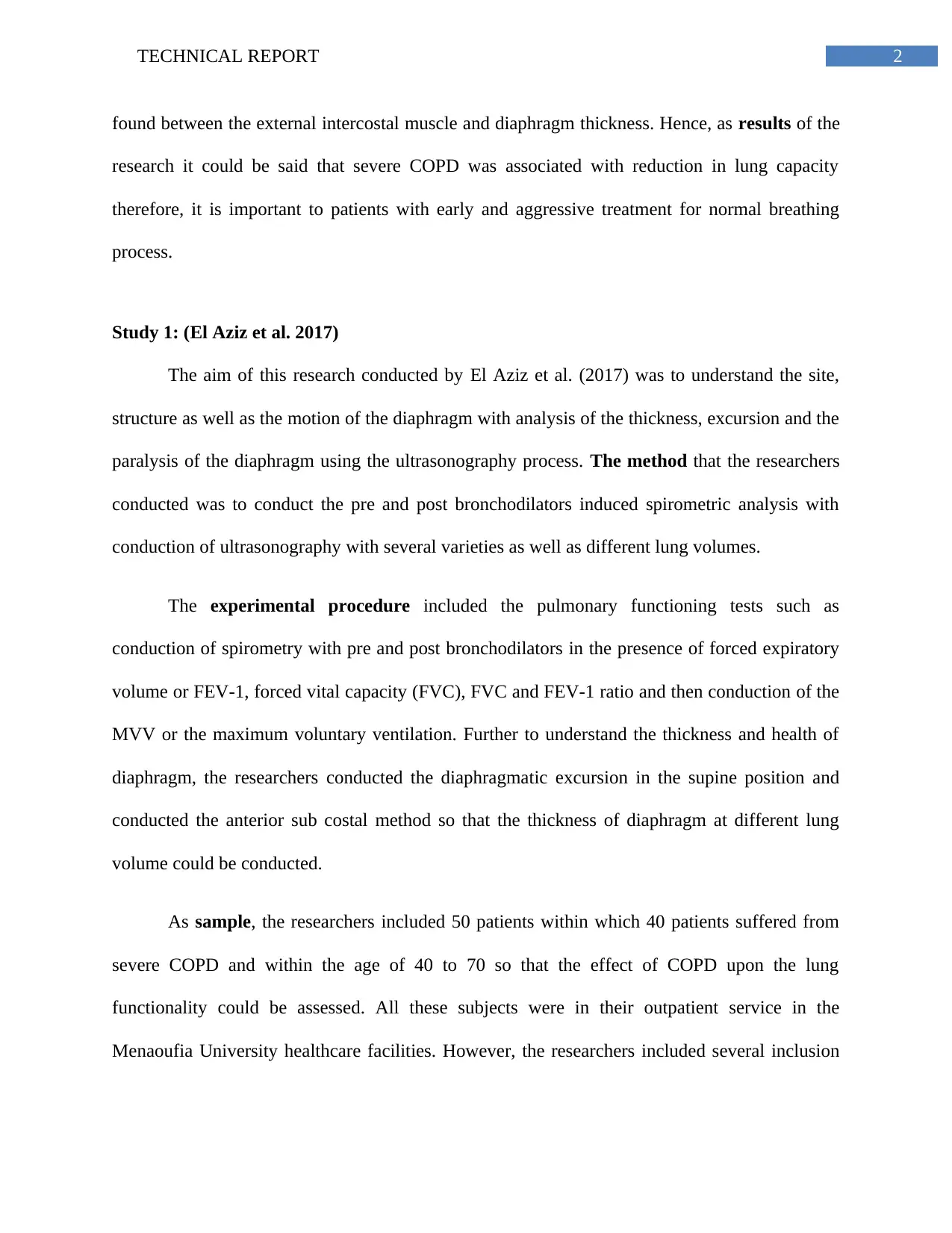
2TECHNICAL REPORT
found between the external intercostal muscle and diaphragm thickness. Hence, as results of the
research it could be said that severe COPD was associated with reduction in lung capacity
therefore, it is important to patients with early and aggressive treatment for normal breathing
process.
Study 1: (El Aziz et al. 2017)
The aim of this research conducted by El Aziz et al. (2017) was to understand the site,
structure as well as the motion of the diaphragm with analysis of the thickness, excursion and the
paralysis of the diaphragm using the ultrasonography process. The method that the researchers
conducted was to conduct the pre and post bronchodilators induced spirometric analysis with
conduction of ultrasonography with several varieties as well as different lung volumes.
The experimental procedure included the pulmonary functioning tests such as
conduction of spirometry with pre and post bronchodilators in the presence of forced expiratory
volume or FEV-1, forced vital capacity (FVC), FVC and FEV-1 ratio and then conduction of the
MVV or the maximum voluntary ventilation. Further to understand the thickness and health of
diaphragm, the researchers conducted the diaphragmatic excursion in the supine position and
conducted the anterior sub costal method so that the thickness of diaphragm at different lung
volume could be conducted.
As sample, the researchers included 50 patients within which 40 patients suffered from
severe COPD and within the age of 40 to 70 so that the effect of COPD upon the lung
functionality could be assessed. All these subjects were in their outpatient service in the
Menaoufia University healthcare facilities. However, the researchers included several inclusion
found between the external intercostal muscle and diaphragm thickness. Hence, as results of the
research it could be said that severe COPD was associated with reduction in lung capacity
therefore, it is important to patients with early and aggressive treatment for normal breathing
process.
Study 1: (El Aziz et al. 2017)
The aim of this research conducted by El Aziz et al. (2017) was to understand the site,
structure as well as the motion of the diaphragm with analysis of the thickness, excursion and the
paralysis of the diaphragm using the ultrasonography process. The method that the researchers
conducted was to conduct the pre and post bronchodilators induced spirometric analysis with
conduction of ultrasonography with several varieties as well as different lung volumes.
The experimental procedure included the pulmonary functioning tests such as
conduction of spirometry with pre and post bronchodilators in the presence of forced expiratory
volume or FEV-1, forced vital capacity (FVC), FVC and FEV-1 ratio and then conduction of the
MVV or the maximum voluntary ventilation. Further to understand the thickness and health of
diaphragm, the researchers conducted the diaphragmatic excursion in the supine position and
conducted the anterior sub costal method so that the thickness of diaphragm at different lung
volume could be conducted.
As sample, the researchers included 50 patients within which 40 patients suffered from
severe COPD and within the age of 40 to 70 so that the effect of COPD upon the lung
functionality could be assessed. All these subjects were in their outpatient service in the
Menaoufia University healthcare facilities. However, the researchers included several inclusion
⊘ This is a preview!⊘
Do you want full access?
Subscribe today to unlock all pages.

Trusted by 1+ million students worldwide
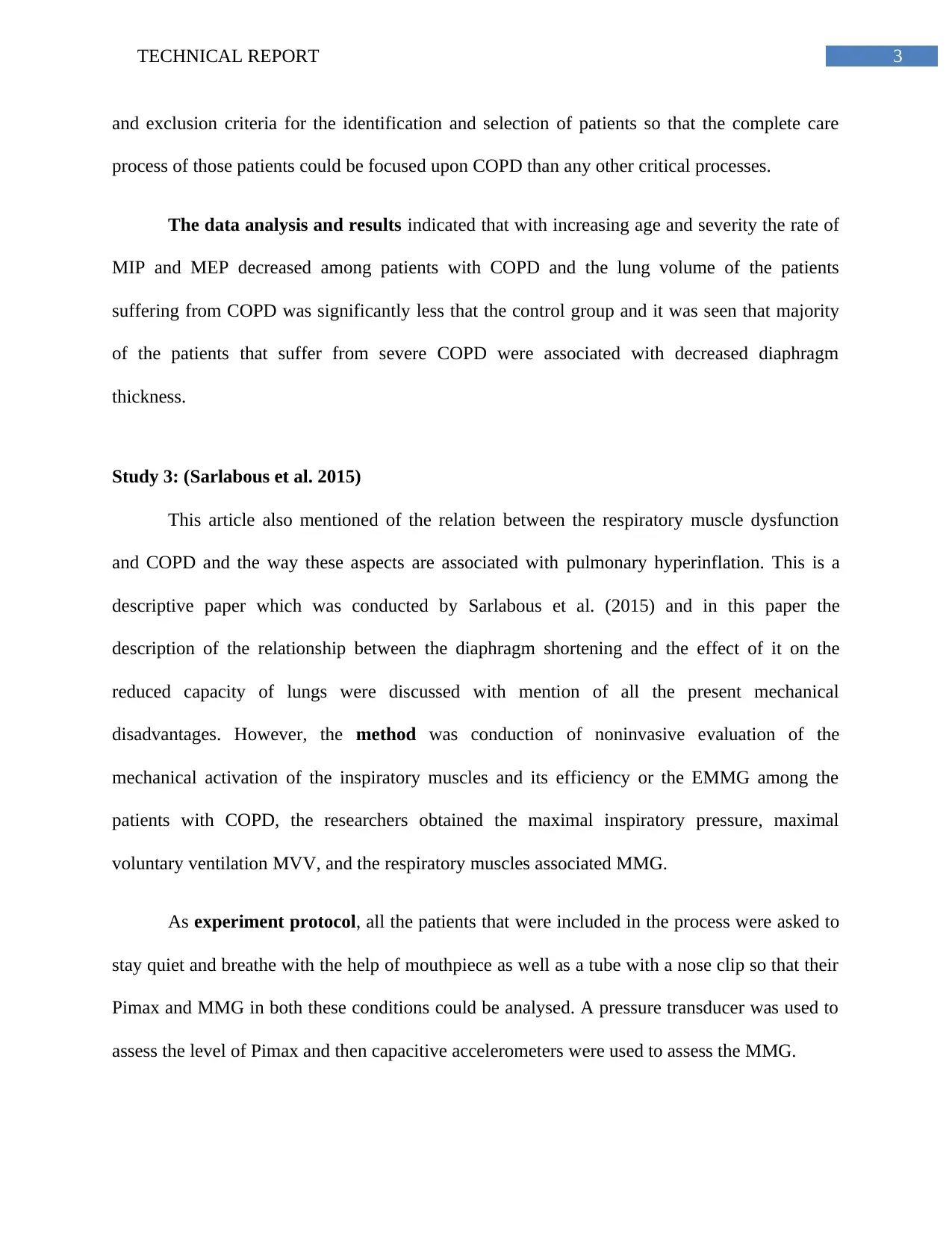
3TECHNICAL REPORT
and exclusion criteria for the identification and selection of patients so that the complete care
process of those patients could be focused upon COPD than any other critical processes.
The data analysis and results indicated that with increasing age and severity the rate of
MIP and MEP decreased among patients with COPD and the lung volume of the patients
suffering from COPD was significantly less that the control group and it was seen that majority
of the patients that suffer from severe COPD were associated with decreased diaphragm
thickness.
Study 3: (Sarlabous et al. 2015)
This article also mentioned of the relation between the respiratory muscle dysfunction
and COPD and the way these aspects are associated with pulmonary hyperinflation. This is a
descriptive paper which was conducted by Sarlabous et al. (2015) and in this paper the
description of the relationship between the diaphragm shortening and the effect of it on the
reduced capacity of lungs were discussed with mention of all the present mechanical
disadvantages. However, the method was conduction of noninvasive evaluation of the
mechanical activation of the inspiratory muscles and its efficiency or the EMMG among the
patients with COPD, the researchers obtained the maximal inspiratory pressure, maximal
voluntary ventilation MVV, and the respiratory muscles associated MMG.
As experiment protocol, all the patients that were included in the process were asked to
stay quiet and breathe with the help of mouthpiece as well as a tube with a nose clip so that their
Pimax and MMG in both these conditions could be analysed. A pressure transducer was used to
assess the level of Pimax and then capacitive accelerometers were used to assess the MMG.
and exclusion criteria for the identification and selection of patients so that the complete care
process of those patients could be focused upon COPD than any other critical processes.
The data analysis and results indicated that with increasing age and severity the rate of
MIP and MEP decreased among patients with COPD and the lung volume of the patients
suffering from COPD was significantly less that the control group and it was seen that majority
of the patients that suffer from severe COPD were associated with decreased diaphragm
thickness.
Study 3: (Sarlabous et al. 2015)
This article also mentioned of the relation between the respiratory muscle dysfunction
and COPD and the way these aspects are associated with pulmonary hyperinflation. This is a
descriptive paper which was conducted by Sarlabous et al. (2015) and in this paper the
description of the relationship between the diaphragm shortening and the effect of it on the
reduced capacity of lungs were discussed with mention of all the present mechanical
disadvantages. However, the method was conduction of noninvasive evaluation of the
mechanical activation of the inspiratory muscles and its efficiency or the EMMG among the
patients with COPD, the researchers obtained the maximal inspiratory pressure, maximal
voluntary ventilation MVV, and the respiratory muscles associated MMG.
As experiment protocol, all the patients that were included in the process were asked to
stay quiet and breathe with the help of mouthpiece as well as a tube with a nose clip so that their
Pimax and MMG in both these conditions could be analysed. A pressure transducer was used to
assess the level of Pimax and then capacitive accelerometers were used to assess the MMG.
Paraphrase This Document
Need a fresh take? Get an instant paraphrase of this document with our AI Paraphraser
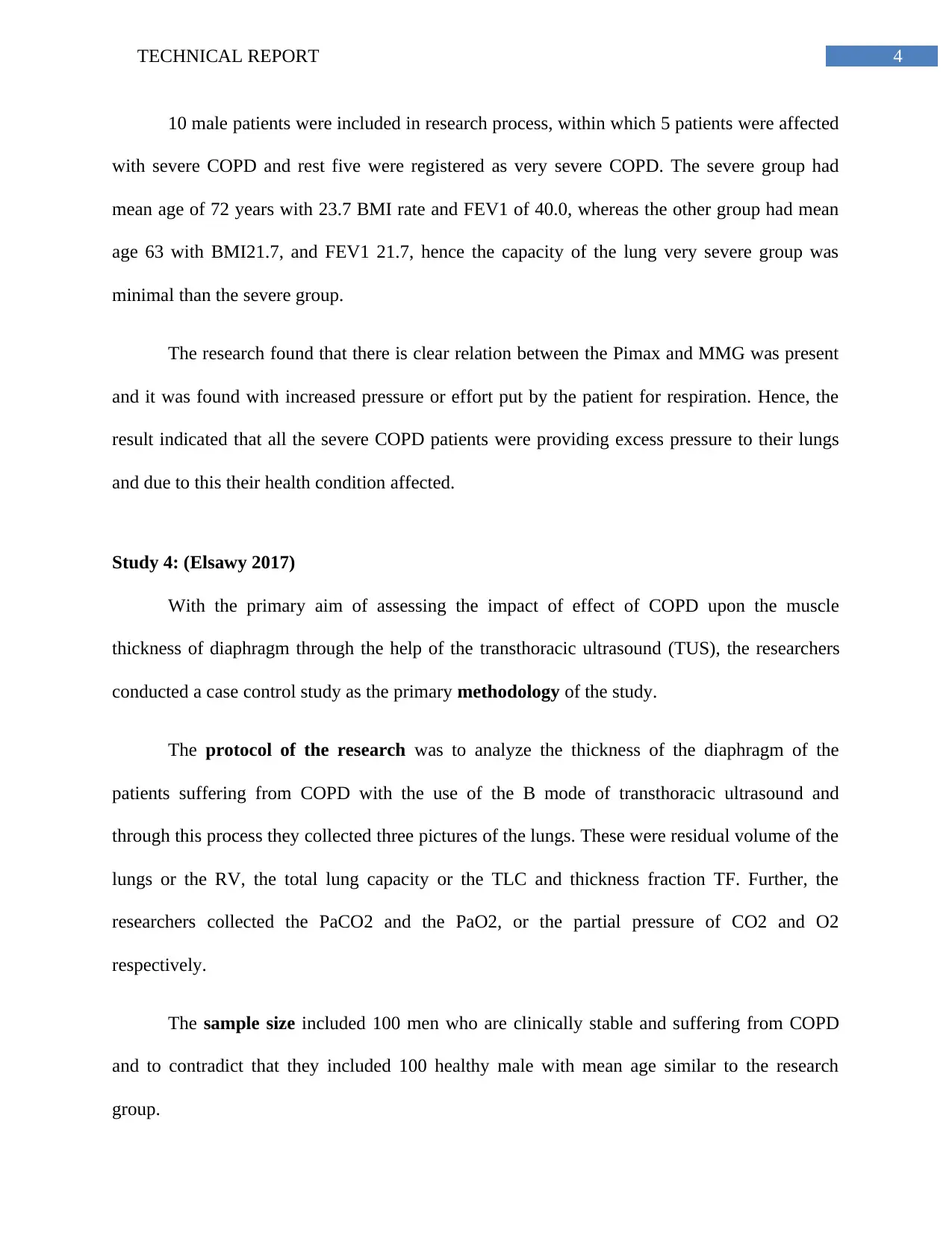
4TECHNICAL REPORT
10 male patients were included in research process, within which 5 patients were affected
with severe COPD and rest five were registered as very severe COPD. The severe group had
mean age of 72 years with 23.7 BMI rate and FEV1 of 40.0, whereas the other group had mean
age 63 with BMI21.7, and FEV1 21.7, hence the capacity of the lung very severe group was
minimal than the severe group.
The research found that there is clear relation between the Pimax and MMG was present
and it was found with increased pressure or effort put by the patient for respiration. Hence, the
result indicated that all the severe COPD patients were providing excess pressure to their lungs
and due to this their health condition affected.
Study 4: (Elsawy 2017)
With the primary aim of assessing the impact of effect of COPD upon the muscle
thickness of diaphragm through the help of the transthoracic ultrasound (TUS), the researchers
conducted a case control study as the primary methodology of the study.
The protocol of the research was to analyze the thickness of the diaphragm of the
patients suffering from COPD with the use of the B mode of transthoracic ultrasound and
through this process they collected three pictures of the lungs. These were residual volume of the
lungs or the RV, the total lung capacity or the TLC and thickness fraction TF. Further, the
researchers collected the PaCO2 and the PaO2, or the partial pressure of CO2 and O2
respectively.
The sample size included 100 men who are clinically stable and suffering from COPD
and to contradict that they included 100 healthy male with mean age similar to the research
group.
10 male patients were included in research process, within which 5 patients were affected
with severe COPD and rest five were registered as very severe COPD. The severe group had
mean age of 72 years with 23.7 BMI rate and FEV1 of 40.0, whereas the other group had mean
age 63 with BMI21.7, and FEV1 21.7, hence the capacity of the lung very severe group was
minimal than the severe group.
The research found that there is clear relation between the Pimax and MMG was present
and it was found with increased pressure or effort put by the patient for respiration. Hence, the
result indicated that all the severe COPD patients were providing excess pressure to their lungs
and due to this their health condition affected.
Study 4: (Elsawy 2017)
With the primary aim of assessing the impact of effect of COPD upon the muscle
thickness of diaphragm through the help of the transthoracic ultrasound (TUS), the researchers
conducted a case control study as the primary methodology of the study.
The protocol of the research was to analyze the thickness of the diaphragm of the
patients suffering from COPD with the use of the B mode of transthoracic ultrasound and
through this process they collected three pictures of the lungs. These were residual volume of the
lungs or the RV, the total lung capacity or the TLC and thickness fraction TF. Further, the
researchers collected the PaCO2 and the PaO2, or the partial pressure of CO2 and O2
respectively.
The sample size included 100 men who are clinically stable and suffering from COPD
and to contradict that they included 100 healthy male with mean age similar to the research
group.
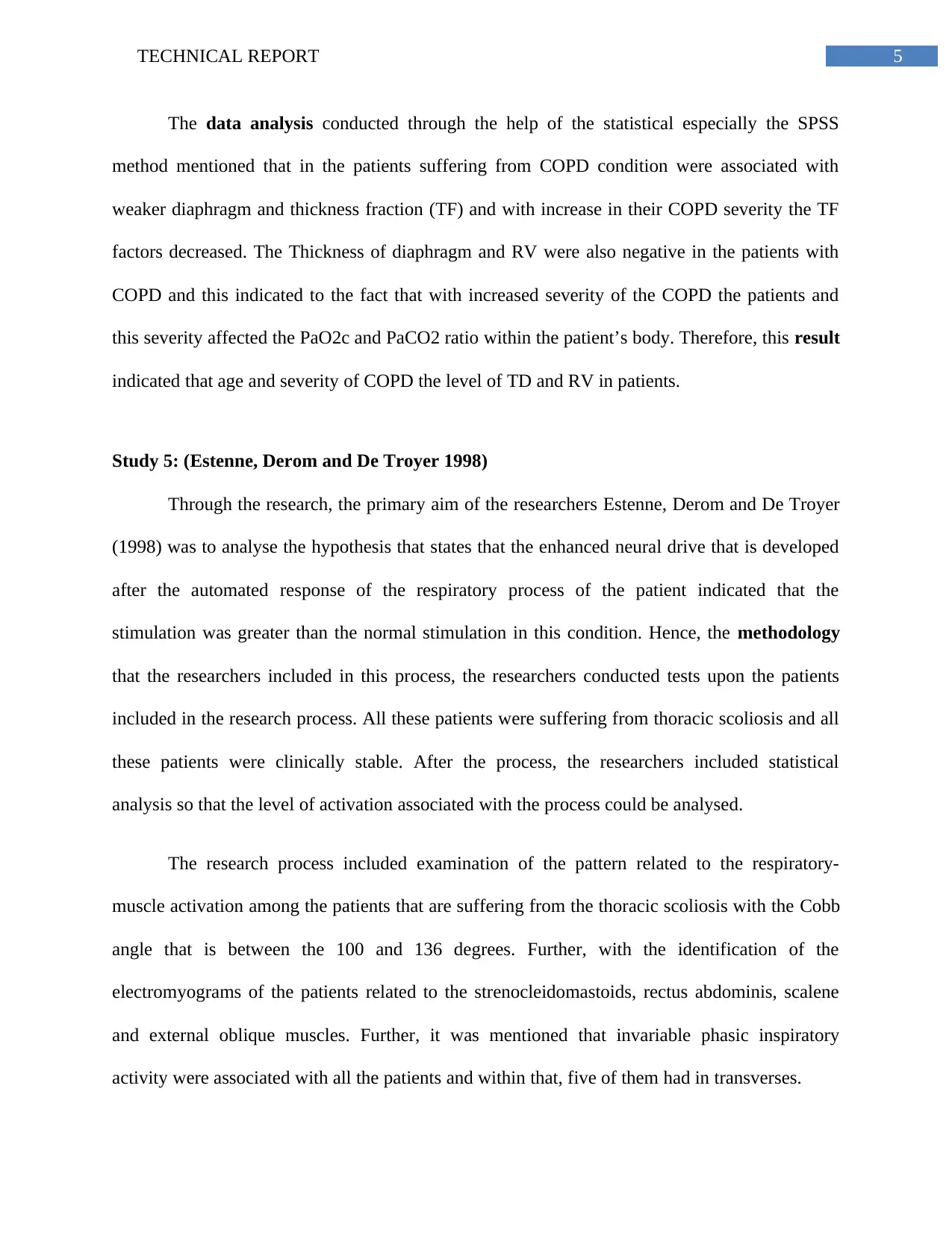
5TECHNICAL REPORT
The data analysis conducted through the help of the statistical especially the SPSS
method mentioned that in the patients suffering from COPD condition were associated with
weaker diaphragm and thickness fraction (TF) and with increase in their COPD severity the TF
factors decreased. The Thickness of diaphragm and RV were also negative in the patients with
COPD and this indicated to the fact that with increased severity of the COPD the patients and
this severity affected the PaO2c and PaCO2 ratio within the patient’s body. Therefore, this result
indicated that age and severity of COPD the level of TD and RV in patients.
Study 5: (Estenne, Derom and De Troyer 1998)
Through the research, the primary aim of the researchers Estenne, Derom and De Troyer
(1998) was to analyse the hypothesis that states that the enhanced neural drive that is developed
after the automated response of the respiratory process of the patient indicated that the
stimulation was greater than the normal stimulation in this condition. Hence, the methodology
that the researchers included in this process, the researchers conducted tests upon the patients
included in the research process. All these patients were suffering from thoracic scoliosis and all
these patients were clinically stable. After the process, the researchers included statistical
analysis so that the level of activation associated with the process could be analysed.
The research process included examination of the pattern related to the respiratory-
muscle activation among the patients that are suffering from the thoracic scoliosis with the Cobb
angle that is between the 100 and 136 degrees. Further, with the identification of the
electromyograms of the patients related to the strenocleidomastoids, rectus abdominis, scalene
and external oblique muscles. Further, it was mentioned that invariable phasic inspiratory
activity were associated with all the patients and within that, five of them had in transverses.
The data analysis conducted through the help of the statistical especially the SPSS
method mentioned that in the patients suffering from COPD condition were associated with
weaker diaphragm and thickness fraction (TF) and with increase in their COPD severity the TF
factors decreased. The Thickness of diaphragm and RV were also negative in the patients with
COPD and this indicated to the fact that with increased severity of the COPD the patients and
this severity affected the PaO2c and PaCO2 ratio within the patient’s body. Therefore, this result
indicated that age and severity of COPD the level of TD and RV in patients.
Study 5: (Estenne, Derom and De Troyer 1998)
Through the research, the primary aim of the researchers Estenne, Derom and De Troyer
(1998) was to analyse the hypothesis that states that the enhanced neural drive that is developed
after the automated response of the respiratory process of the patient indicated that the
stimulation was greater than the normal stimulation in this condition. Hence, the methodology
that the researchers included in this process, the researchers conducted tests upon the patients
included in the research process. All these patients were suffering from thoracic scoliosis and all
these patients were clinically stable. After the process, the researchers included statistical
analysis so that the level of activation associated with the process could be analysed.
The research process included examination of the pattern related to the respiratory-
muscle activation among the patients that are suffering from the thoracic scoliosis with the Cobb
angle that is between the 100 and 136 degrees. Further, with the identification of the
electromyograms of the patients related to the strenocleidomastoids, rectus abdominis, scalene
and external oblique muscles. Further, it was mentioned that invariable phasic inspiratory
activity were associated with all the patients and within that, five of them had in transverses.
⊘ This is a preview!⊘
Do you want full access?
Subscribe today to unlock all pages.

Trusted by 1+ million students worldwide
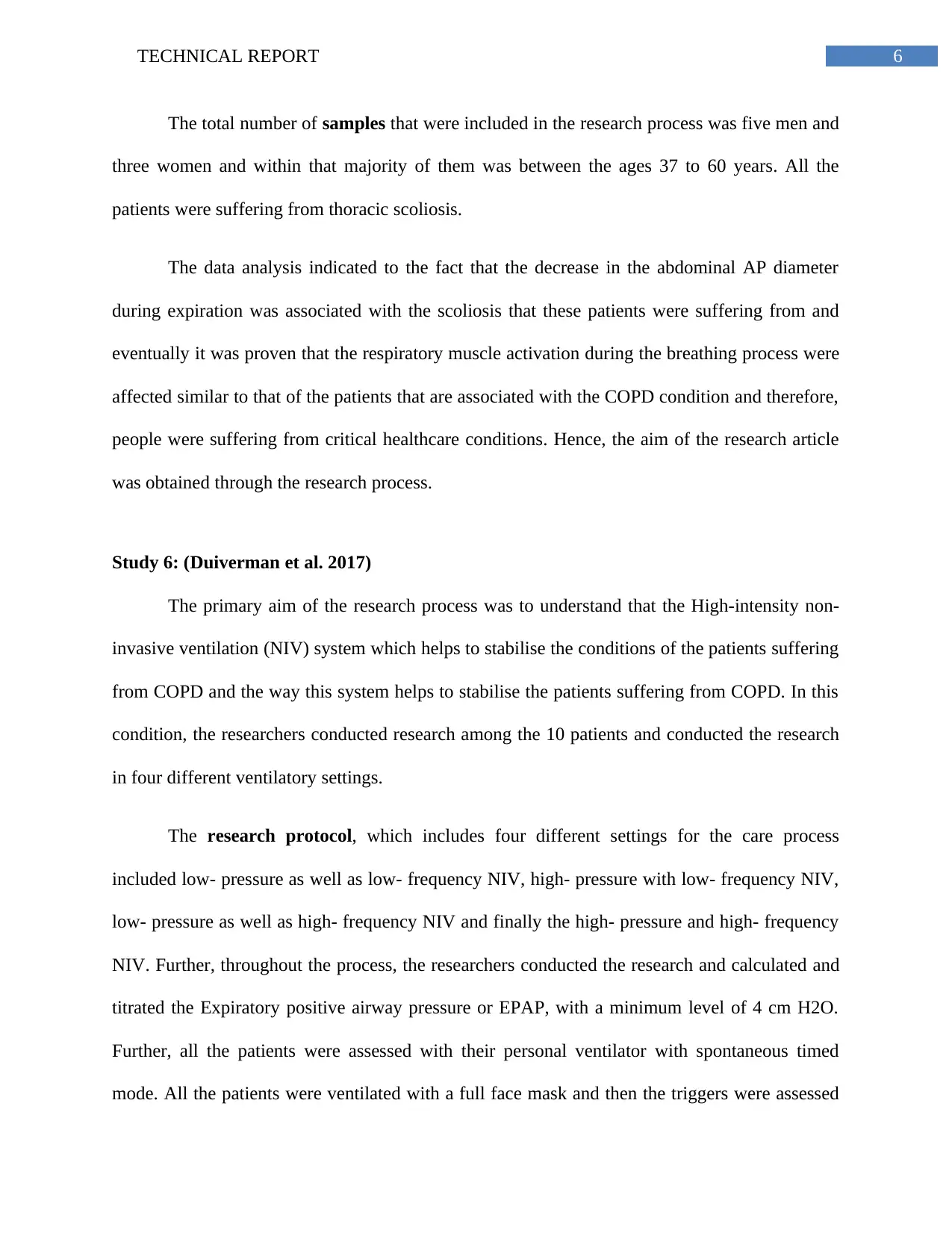
6TECHNICAL REPORT
The total number of samples that were included in the research process was five men and
three women and within that majority of them was between the ages 37 to 60 years. All the
patients were suffering from thoracic scoliosis.
The data analysis indicated to the fact that the decrease in the abdominal AP diameter
during expiration was associated with the scoliosis that these patients were suffering from and
eventually it was proven that the respiratory muscle activation during the breathing process were
affected similar to that of the patients that are associated with the COPD condition and therefore,
people were suffering from critical healthcare conditions. Hence, the aim of the research article
was obtained through the research process.
Study 6: (Duiverman et al. 2017)
The primary aim of the research process was to understand that the High-intensity non-
invasive ventilation (NIV) system which helps to stabilise the conditions of the patients suffering
from COPD and the way this system helps to stabilise the patients suffering from COPD. In this
condition, the researchers conducted research among the 10 patients and conducted the research
in four different ventilatory settings.
The research protocol, which includes four different settings for the care process
included low- pressure as well as low- frequency NIV, high- pressure with low- frequency NIV,
low- pressure as well as high- frequency NIV and finally the high- pressure and high- frequency
NIV. Further, throughout the process, the researchers conducted the research and calculated and
titrated the Expiratory positive airway pressure or EPAP, with a minimum level of 4 cm H2O.
Further, all the patients were assessed with their personal ventilator with spontaneous timed
mode. All the patients were ventilated with a full face mask and then the triggers were assessed
The total number of samples that were included in the research process was five men and
three women and within that majority of them was between the ages 37 to 60 years. All the
patients were suffering from thoracic scoliosis.
The data analysis indicated to the fact that the decrease in the abdominal AP diameter
during expiration was associated with the scoliosis that these patients were suffering from and
eventually it was proven that the respiratory muscle activation during the breathing process were
affected similar to that of the patients that are associated with the COPD condition and therefore,
people were suffering from critical healthcare conditions. Hence, the aim of the research article
was obtained through the research process.
Study 6: (Duiverman et al. 2017)
The primary aim of the research process was to understand that the High-intensity non-
invasive ventilation (NIV) system which helps to stabilise the conditions of the patients suffering
from COPD and the way this system helps to stabilise the patients suffering from COPD. In this
condition, the researchers conducted research among the 10 patients and conducted the research
in four different ventilatory settings.
The research protocol, which includes four different settings for the care process
included low- pressure as well as low- frequency NIV, high- pressure with low- frequency NIV,
low- pressure as well as high- frequency NIV and finally the high- pressure and high- frequency
NIV. Further, throughout the process, the researchers conducted the research and calculated and
titrated the Expiratory positive airway pressure or EPAP, with a minimum level of 4 cm H2O.
Further, all the patients were assessed with their personal ventilator with spontaneous timed
mode. All the patients were ventilated with a full face mask and then the triggers were assessed
Paraphrase This Document
Need a fresh take? Get an instant paraphrase of this document with our AI Paraphraser
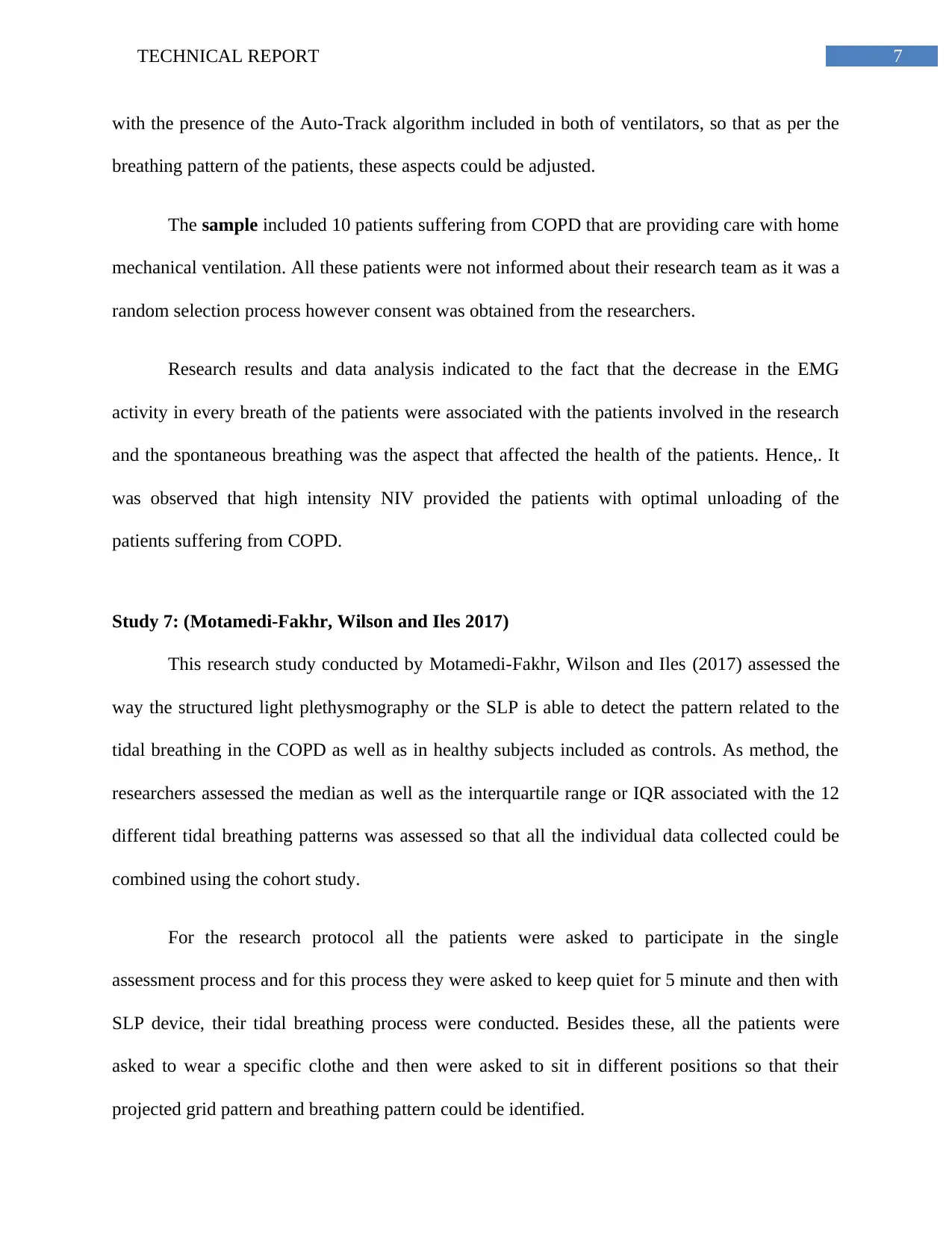
7TECHNICAL REPORT
with the presence of the Auto-Track algorithm included in both of ventilators, so that as per the
breathing pattern of the patients, these aspects could be adjusted.
The sample included 10 patients suffering from COPD that are providing care with home
mechanical ventilation. All these patients were not informed about their research team as it was a
random selection process however consent was obtained from the researchers.
Research results and data analysis indicated to the fact that the decrease in the EMG
activity in every breath of the patients were associated with the patients involved in the research
and the spontaneous breathing was the aspect that affected the health of the patients. Hence,. It
was observed that high intensity NIV provided the patients with optimal unloading of the
patients suffering from COPD.
Study 7: (Motamedi-Fakhr, Wilson and Iles 2017)
This research study conducted by Motamedi-Fakhr, Wilson and Iles (2017) assessed the
way the structured light plethysmography or the SLP is able to detect the pattern related to the
tidal breathing in the COPD as well as in healthy subjects included as controls. As method, the
researchers assessed the median as well as the interquartile range or IQR associated with the 12
different tidal breathing patterns was assessed so that all the individual data collected could be
combined using the cohort study.
For the research protocol all the patients were asked to participate in the single
assessment process and for this process they were asked to keep quiet for 5 minute and then with
SLP device, their tidal breathing process were conducted. Besides these, all the patients were
asked to wear a specific clothe and then were asked to sit in different positions so that their
projected grid pattern and breathing pattern could be identified.
with the presence of the Auto-Track algorithm included in both of ventilators, so that as per the
breathing pattern of the patients, these aspects could be adjusted.
The sample included 10 patients suffering from COPD that are providing care with home
mechanical ventilation. All these patients were not informed about their research team as it was a
random selection process however consent was obtained from the researchers.
Research results and data analysis indicated to the fact that the decrease in the EMG
activity in every breath of the patients were associated with the patients involved in the research
and the spontaneous breathing was the aspect that affected the health of the patients. Hence,. It
was observed that high intensity NIV provided the patients with optimal unloading of the
patients suffering from COPD.
Study 7: (Motamedi-Fakhr, Wilson and Iles 2017)
This research study conducted by Motamedi-Fakhr, Wilson and Iles (2017) assessed the
way the structured light plethysmography or the SLP is able to detect the pattern related to the
tidal breathing in the COPD as well as in healthy subjects included as controls. As method, the
researchers assessed the median as well as the interquartile range or IQR associated with the 12
different tidal breathing patterns was assessed so that all the individual data collected could be
combined using the cohort study.
For the research protocol all the patients were asked to participate in the single
assessment process and for this process they were asked to keep quiet for 5 minute and then with
SLP device, their tidal breathing process were conducted. Besides these, all the patients were
asked to wear a specific clothe and then were asked to sit in different positions so that their
projected grid pattern and breathing pattern could be identified.
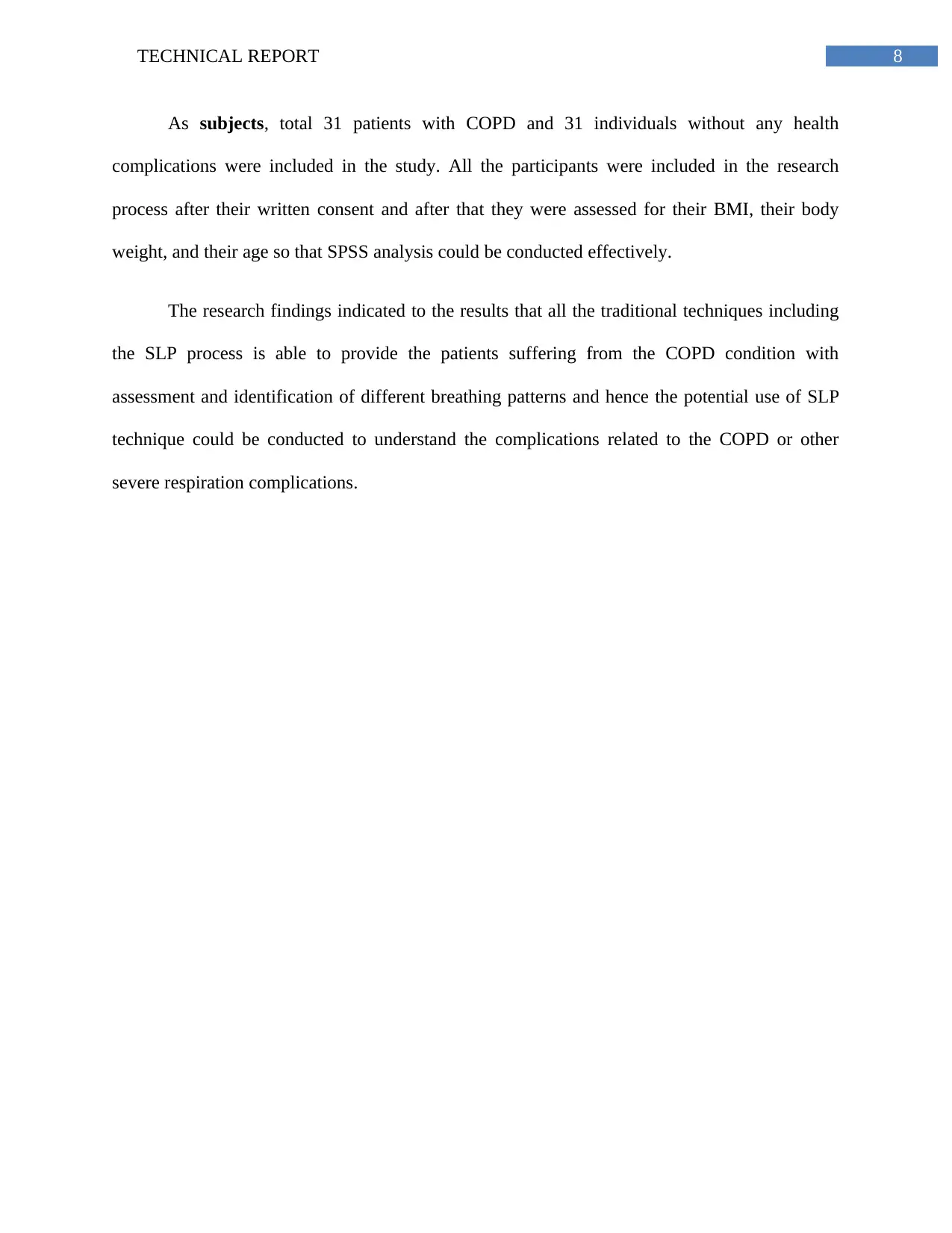
8TECHNICAL REPORT
As subjects, total 31 patients with COPD and 31 individuals without any health
complications were included in the study. All the participants were included in the research
process after their written consent and after that they were assessed for their BMI, their body
weight, and their age so that SPSS analysis could be conducted effectively.
The research findings indicated to the results that all the traditional techniques including
the SLP process is able to provide the patients suffering from the COPD condition with
assessment and identification of different breathing patterns and hence the potential use of SLP
technique could be conducted to understand the complications related to the COPD or other
severe respiration complications.
As subjects, total 31 patients with COPD and 31 individuals without any health
complications were included in the study. All the participants were included in the research
process after their written consent and after that they were assessed for their BMI, their body
weight, and their age so that SPSS analysis could be conducted effectively.
The research findings indicated to the results that all the traditional techniques including
the SLP process is able to provide the patients suffering from the COPD condition with
assessment and identification of different breathing patterns and hence the potential use of SLP
technique could be conducted to understand the complications related to the COPD or other
severe respiration complications.
⊘ This is a preview!⊘
Do you want full access?
Subscribe today to unlock all pages.

Trusted by 1+ million students worldwide
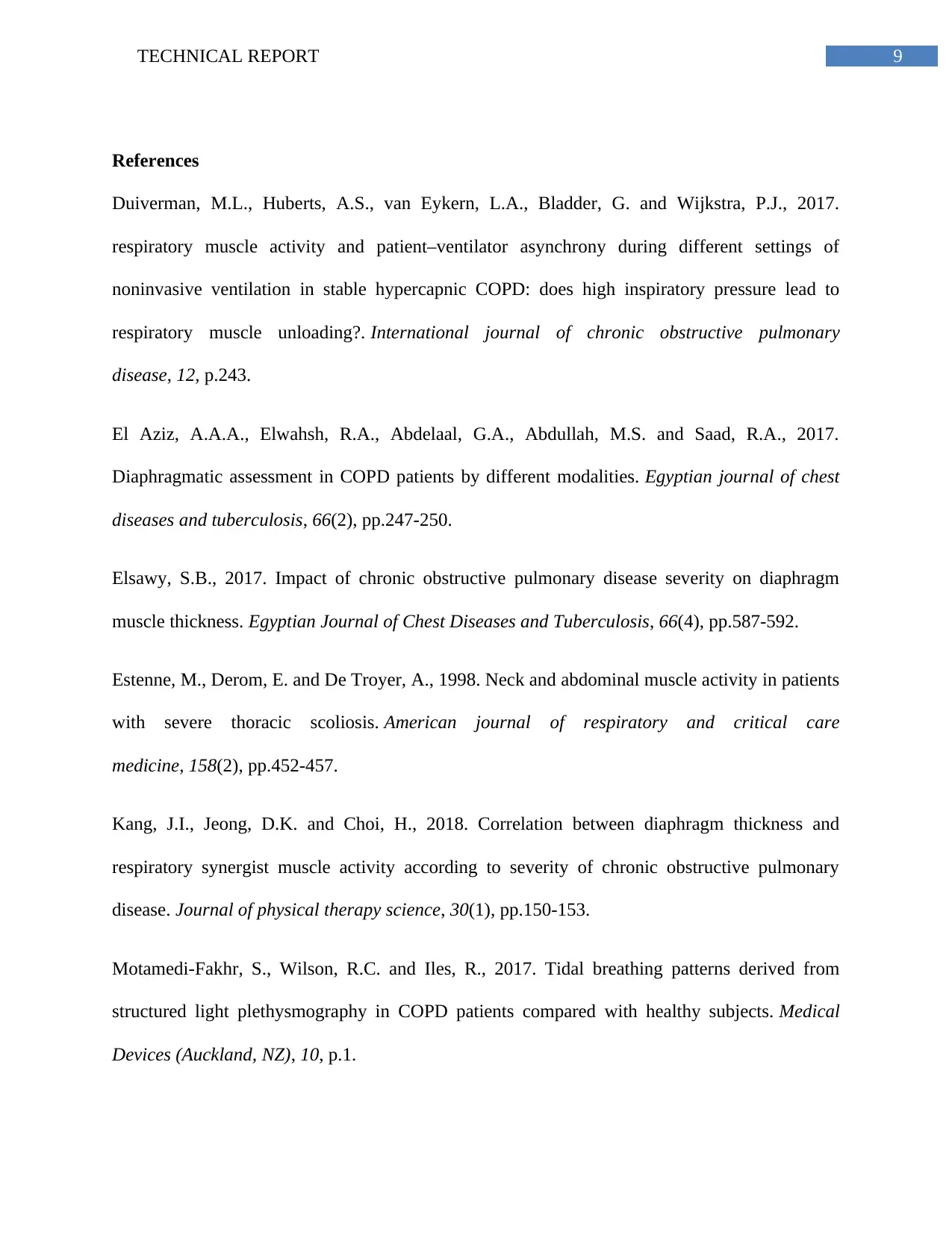
9TECHNICAL REPORT
References
Duiverman, M.L., Huberts, A.S., van Eykern, L.A., Bladder, G. and Wijkstra, P.J., 2017.
respiratory muscle activity and patient–ventilator asynchrony during different settings of
noninvasive ventilation in stable hypercapnic COPD: does high inspiratory pressure lead to
respiratory muscle unloading?. International journal of chronic obstructive pulmonary
disease, 12, p.243.
El Aziz, A.A.A., Elwahsh, R.A., Abdelaal, G.A., Abdullah, M.S. and Saad, R.A., 2017.
Diaphragmatic assessment in COPD patients by different modalities. Egyptian journal of chest
diseases and tuberculosis, 66(2), pp.247-250.
Elsawy, S.B., 2017. Impact of chronic obstructive pulmonary disease severity on diaphragm
muscle thickness. Egyptian Journal of Chest Diseases and Tuberculosis, 66(4), pp.587-592.
Estenne, M., Derom, E. and De Troyer, A., 1998. Neck and abdominal muscle activity in patients
with severe thoracic scoliosis. American journal of respiratory and critical care
medicine, 158(2), pp.452-457.
Kang, J.I., Jeong, D.K. and Choi, H., 2018. Correlation between diaphragm thickness and
respiratory synergist muscle activity according to severity of chronic obstructive pulmonary
disease. Journal of physical therapy science, 30(1), pp.150-153.
Motamedi-Fakhr, S., Wilson, R.C. and Iles, R., 2017. Tidal breathing patterns derived from
structured light plethysmography in COPD patients compared with healthy subjects. Medical
Devices (Auckland, NZ), 10, p.1.
References
Duiverman, M.L., Huberts, A.S., van Eykern, L.A., Bladder, G. and Wijkstra, P.J., 2017.
respiratory muscle activity and patient–ventilator asynchrony during different settings of
noninvasive ventilation in stable hypercapnic COPD: does high inspiratory pressure lead to
respiratory muscle unloading?. International journal of chronic obstructive pulmonary
disease, 12, p.243.
El Aziz, A.A.A., Elwahsh, R.A., Abdelaal, G.A., Abdullah, M.S. and Saad, R.A., 2017.
Diaphragmatic assessment in COPD patients by different modalities. Egyptian journal of chest
diseases and tuberculosis, 66(2), pp.247-250.
Elsawy, S.B., 2017. Impact of chronic obstructive pulmonary disease severity on diaphragm
muscle thickness. Egyptian Journal of Chest Diseases and Tuberculosis, 66(4), pp.587-592.
Estenne, M., Derom, E. and De Troyer, A., 1998. Neck and abdominal muscle activity in patients
with severe thoracic scoliosis. American journal of respiratory and critical care
medicine, 158(2), pp.452-457.
Kang, J.I., Jeong, D.K. and Choi, H., 2018. Correlation between diaphragm thickness and
respiratory synergist muscle activity according to severity of chronic obstructive pulmonary
disease. Journal of physical therapy science, 30(1), pp.150-153.
Motamedi-Fakhr, S., Wilson, R.C. and Iles, R., 2017. Tidal breathing patterns derived from
structured light plethysmography in COPD patients compared with healthy subjects. Medical
Devices (Auckland, NZ), 10, p.1.
Paraphrase This Document
Need a fresh take? Get an instant paraphrase of this document with our AI Paraphraser
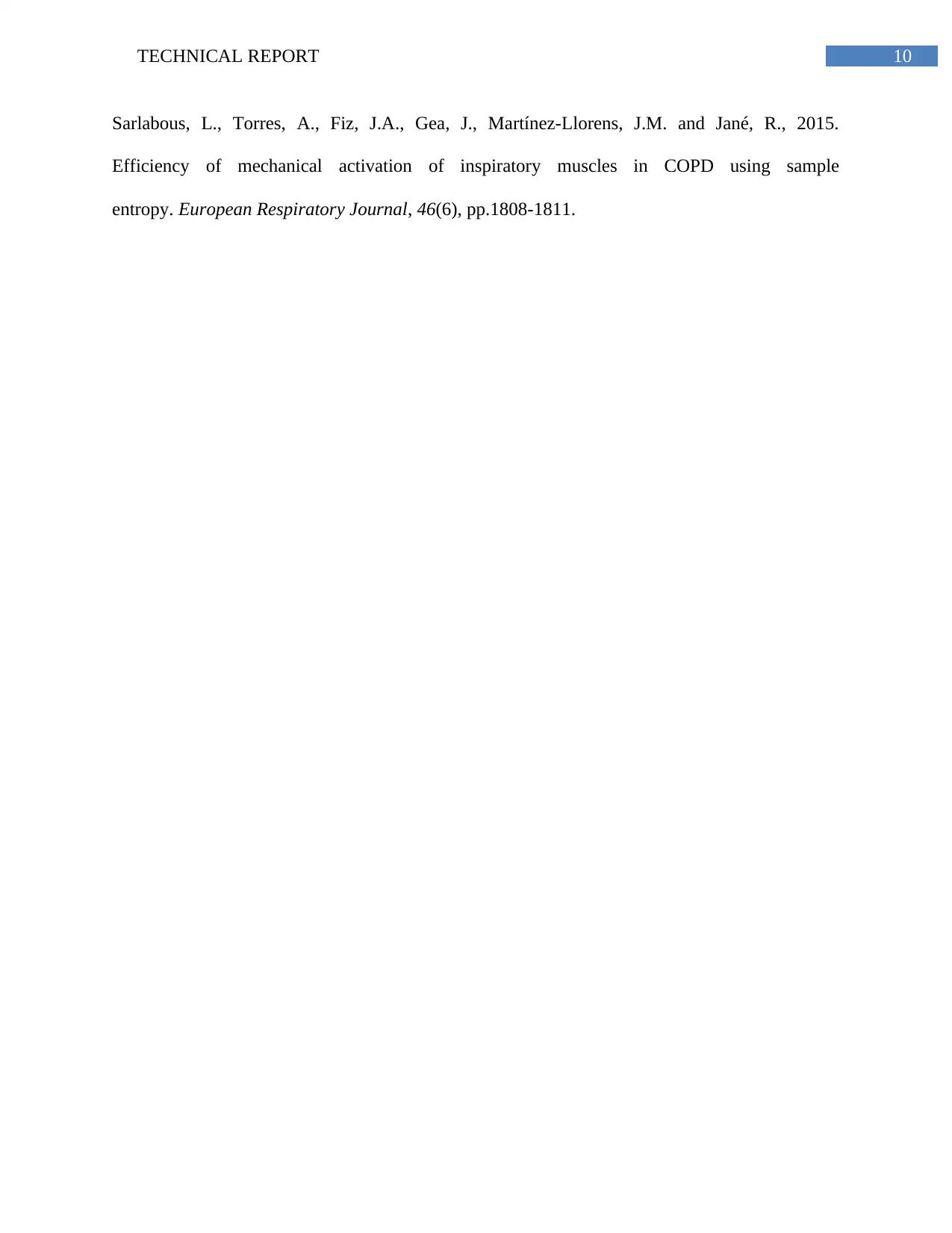
10TECHNICAL REPORT
Sarlabous, L., Torres, A., Fiz, J.A., Gea, J., Martínez-Llorens, J.M. and Jané, R., 2015.
Efficiency of mechanical activation of inspiratory muscles in COPD using sample
entropy. European Respiratory Journal, 46(6), pp.1808-1811.
Sarlabous, L., Torres, A., Fiz, J.A., Gea, J., Martínez-Llorens, J.M. and Jané, R., 2015.
Efficiency of mechanical activation of inspiratory muscles in COPD using sample
entropy. European Respiratory Journal, 46(6), pp.1808-1811.
1 out of 11
Your All-in-One AI-Powered Toolkit for Academic Success.
+13062052269
info@desklib.com
Available 24*7 on WhatsApp / Email
![[object Object]](/_next/static/media/star-bottom.7253800d.svg)
Unlock your academic potential
Copyright © 2020–2025 A2Z Services. All Rights Reserved. Developed and managed by ZUCOL.